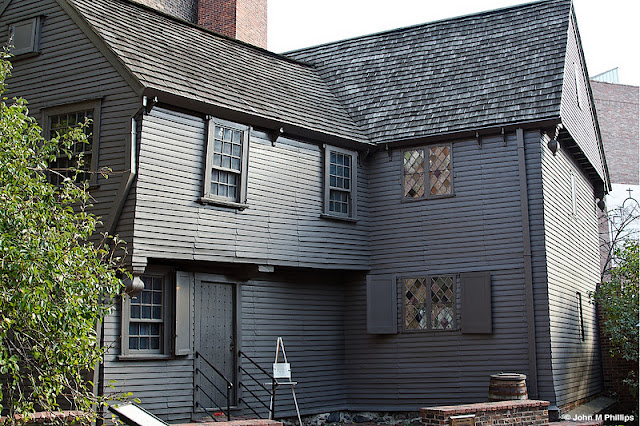To save our legs, we took the MTA to the starting point in Boston Commons and then back to our hotel from a station not far from Bunker Hill.
Here I have chosen to focus on just a few of the places we visited. The first was the Granary Burying Ground.
I found it difficult to provide a proper perspective for a graveyard, and I wound up taking a number of shots of headstones. I liked this one the best, primarily because of the interesting light. It might have been better had I taken the shot from a slightly lower perspective.
It was interesting to learn that bas relief sculptures of skulls were commonplace on gravestones during that time period.
And, yes, my namesake was the first mayor of the city of Boston.
The key in the shot below was the play of light and shadow, so I turned it into a B&W.
Not a travel photo, but I liked it anyway. The following shot includes an interesting juxtaposition between an old gravestone and a more modern wrought iron fence and building behind it.
The viewer can't identify exactly where this was taken, but it does give a sense of the old and new that the Boston historical area incorporates. The ivy also helps to make the shot.
Here is another typical street scene along the trail. I wish the shot did not include the car, but I would have had to come back at a very different time of day with any hopes of getting that shot.
One of the more impressive sites was a group of sculptures depicting the Irish immigrant experience. There were two sets of sculptures, one featuring a group of self-assured individuals . . .
and a second of a group clearly experiencing anguish and despair.
The young man's face is just too close to the woman's skirt to use depth of field to distinguish the two.
It might have been better to have taken this shot more from the front than from the side.
We did a brief tour of the Paul Revere house, a handsome structure that has been well maintained.
I liked the architectural detail in the following shot.
Next stop was the iconic Paul Revere statue. My problem was the play of sunlight and shadow across the statue. This was not such a big problem for a side shot, but that was not really a very interesting view.
I wanted to capture the statue with the Old North Church in the background, even though as I took the shot I realized that this had to be a very common compostion.
In this first shot, the church steeple is clear, but I wanted it to be larger in the shot, as in the photo below.
Unfortunately, the white steeple is somewhat lost against the white clouds behind it. And of course there were those strong shadows running across the Revere statue.
I then turned around and realized that the lighting was much better if the statue was shot from behind, and the handsome St. Stephen's Church with its bell tower provided a very nice backdrop.
I felt the trees on either side helped to focus attention on the statue and church, and it helped that the bell was fully visible. A minor regret was that it would have been nice if the statue had been a bit larger in the shot. In addition, resolution of this shot is a bit soft.
The Benjamin Franklin statue is also a Boston icon. I liked how I captured it in the following two shots.
This second shot, in particular, I felt very good about. Instead of having the statue fill the image, I included a significant amount of the background building to provide context. The trees on either side and in front provided depth. It also helped that the trees were showing their fall colors. The statue is also in exceptional focus. Usually, I am trying to learn something from my mistakes. The above photo was, I felt, a classic travel photo, and hopefully I learned something from its success.
The Freedom Trail ends at the Bunker Hill monument, which is fronted by another interesting statue, this time of Col. William Prescott, who was instrumental in the battle by that name. By this time the sky had clouded over, and I decided to convert the shots I took of the statue to near-B&Ws.
The first shot, with part of the Bunker Hill obelisk in the background, is probably the best of the three, although I liked the positioning of the Colonel's left arm in the third shot. The buildings in the background are a bit of a distraction. Either they should have been excluded by taking the shot from a lower angle or they should have been given a more prominent role. I do feel that the conversion to B&W added to these shots.
























No comments:
Post a Comment
Note: Only a member of this blog may post a comment.